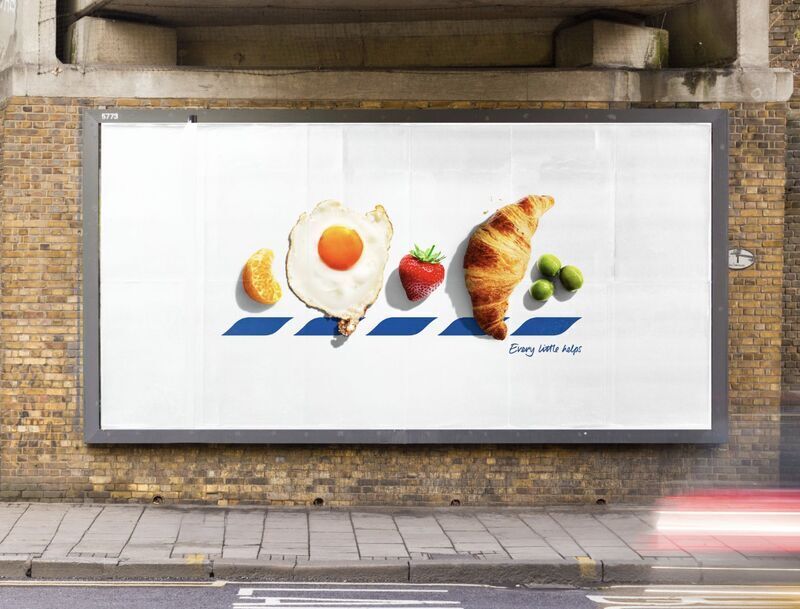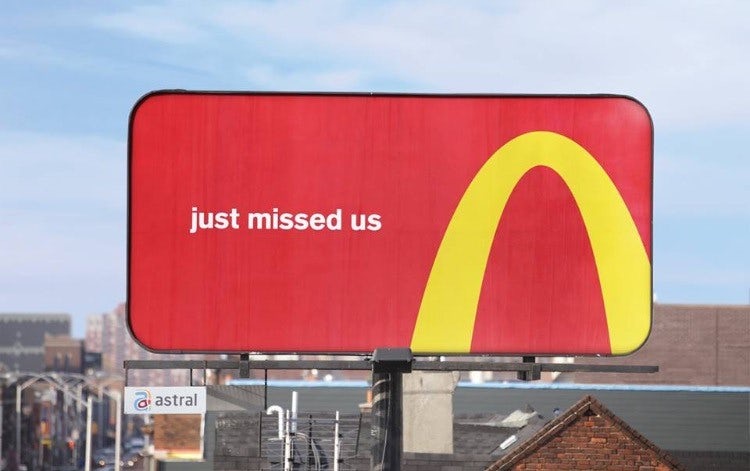Exploiting the Zeigarnik effect will make your ads more…

Exploiting the Zeigarnik effect will make your ads more…
…memorable, because our brains are more likely to recall tasks that were left unfinished than those that were completed.
There has been lots of debate this week about those Tesco billboards. You know, the ones that don’t say Tesco on them. Hence the debate. All you do see, in a new series of ads from BBH, are the five blue dashes that usually support the Tesco logo. But instead of the red letters appearing above them, you get a wide array of different foods whose initials, you eventually work out, spell Tesco.
Several marketers have taken to social media to proclaim the work “underwhelming”. As one critic put it: “A billboard should be INSTANTLY recognisable.” Unfortunately, this time the negativity is misplaced. Many marketers have completely missed the point and the sublime cleverness of Tesco and its dazzling agency. This is brand building at its finest.
To understand why, you need to travel to Berlin a century ago and meet a young Lithuanian psychologist called Bluma Zeigarnik. She is sat having dinner with her partner at a restaurant near the university. She watches the white-jacketed waiters and their amazing facility to remember the complex orders for food from a multitude of tables. Their memories work remarkably well but only while the service is taking place and the orders are unpaid. She notes that once the food has been delivered and paid for, the same waiters have almost no recollection of what their orders consisted of.
Fast-forward to a lab at the University of Berlin a year later. Zeigarnik is conducting her doctoral research on local German children. The children are working on a series of simple mental puzzles. After they complete half the tasks, Zeigarnik deliberately interrupts the challenge. Later she observes that the children were able to recall their unfinished tasks far better than the completed ones. She repeats her experiments with adults and again shows that incomplete tasks are remembered 90% better than those that were finished.
By leaving apparently basic marketing work undone, we can engage consumers to remember our brands much better and for longer.
The Zeigarnik effect has been studied by countless other researchers ever since. Most conclude that the cognitive tension that arises from a task being unfinished and the need to keep the task in mind to complete it later improve the cognitive accessibility of the task in human memory.
You experience the Zeigarnik effect all the time. The cliff-hanging ending of that latest Netflix series means you think about it more clearly than one that ended in a satisfactory way the same night. That novel you did not finish last summer is far easier to recollect than all the ones you finished. My wife still thinks about a relatively mundane, brand-new blue jacket she left on a plane and never got to wear, over the hundred options hanging in her wardrobe. I remember ‘shout’ much better than any of the other Wordle answers this week because it was the one I did not have time to complete. Things presented as incomplete that you cannot successfully process take up more of your brain, more of your memory and stay with you more as a result.
Creating the answer from within
By the same token, a billboard of fresh food with a Tesco logo underneath it would have made a lot more cognitive sense and required much less processing than apparently random fruit and a blue dotted line. But this more obvious and complete billboard would miss out on the Zeigarnik effect. The effect of a motorist scrunching up her eyes once or twice before working it out. Or marketers on LinkedIn this week trying to work out why the ‘E’ in Tesco was being spelled out by a slice of apple (it wasn’t, it was Edam cheese). Each and every case results in Zeigarnik effects.
And when these viewers complete the word ‘Tesco’ in their head rather than processing it passively via their eyes, a second effect kicks in. The ‘generation effect’ is another discovery from cognitive psychology and it occurs when subjects create or construct the answer rather than have it fed to them; the recall of that answer increases. Challenging someone to remember the opposite of cold usually results in significantly higher levels of recall than simply asking them to remember the word ‘hot’.
When consumers are presented with partial information, like an abstracted brand code or missing logo, it forces them to fill in the cognitive blanks. And when they do that, the brand is constructed by the consumer rather than being fed to them by advertising. Engagement and recall should improve.
In summary, in a cognitive double-play, the uncertain question of an incomplete ad ushers in Zeigarnik effects, and when the subsequent answer is constructed from the ad’s semantic clues, the generation effect further drives attention, recall and discourse – handy things when it comes to advertising effect.
 Tesco is not the first company to work all this out. McDonald’s has been running wildly successful freeway advertising in America that abstracts the golden arches, leaving them unfinished, directional and open to the Zeigarnik and then generation effects.
Tesco is not the first company to work all this out. McDonald’s has been running wildly successful freeway advertising in America that abstracts the golden arches, leaving them unfinished, directional and open to the Zeigarnik and then generation effects.
 Cadbury has done something similar with its packaging in recent times. Paradoxically, by leaving apparently basic marketing work undone, we can engage consumers to remember our brands much better and for longer.
Cadbury has done something similar with its packaging in recent times. Paradoxically, by leaving apparently basic marketing work undone, we can engage consumers to remember our brands much better and for longer.
Do the unexpected
Not every brand can play this game, of course. I counsel marketers that brand equity (the raw material) and brand management (the person handling it) are two independent variables. And this advanced form of code play requires both in place before you can even countenance this kind of fruity inversion in your advertising.
First, you need brand codes that have been established for at least 30 years – ideally longer. Tesco’s distinctive blue dashes have been in place since 1989 and, after 35 years and umpteen billions of impressions, they are ripe for a little interruption. It might take consumers a couple of takes of the new abstracted billboards to work them out. But the Zeigarnik effect would suggest that is no bad thing.
Second, you need brand managers at the top of their game. Way above the usual officious, conservative marketers who think brand management is policing a consistent look and feel and ensuring everything is written in courier semi-bold using Pantone 1224-C. This is old-school, out-of-touch branding. Marketers must learn to loosen up. To play. To challenge. And, provided your brand has the heritage and the iconicity in place, to do the unexpected. Distinctiveness favours the brave.
It’s true, to quote another critic of the campaign this week, that “everyone driving past can hardly tell this billboard is [Tesco’s]”. But that is entirely the point. Let the fuckers think about it for a while. Hell, let them ponder it for days. Give them something partial and restrict dwell times so they don’t succeed in understanding it immediately.
 And the proof is in the empirical pudding. Research completed this week by Distinctive BAT shows that Tesco’s unrecognisable ad is actually outperforming all of its competitors’ efforts in the outdoor space. More likely to be recognised. More likely to be attributed to Tesco. It’s the sum total of the effects of Zeigarnik and generation combined. Of how ads without logos or simple identification are sometimes more resonant and powerful than those that offer these things up too easily.
And the proof is in the empirical pudding. Research completed this week by Distinctive BAT shows that Tesco’s unrecognisable ad is actually outperforming all of its competitors’ efforts in the outdoor space. More likely to be recognised. More likely to be attributed to Tesco. It’s the sum total of the effects of Zeigarnik and generation combined. Of how ads without logos or simple identification are sometimes more resonant and powerful than those that offer these things up too easily.
